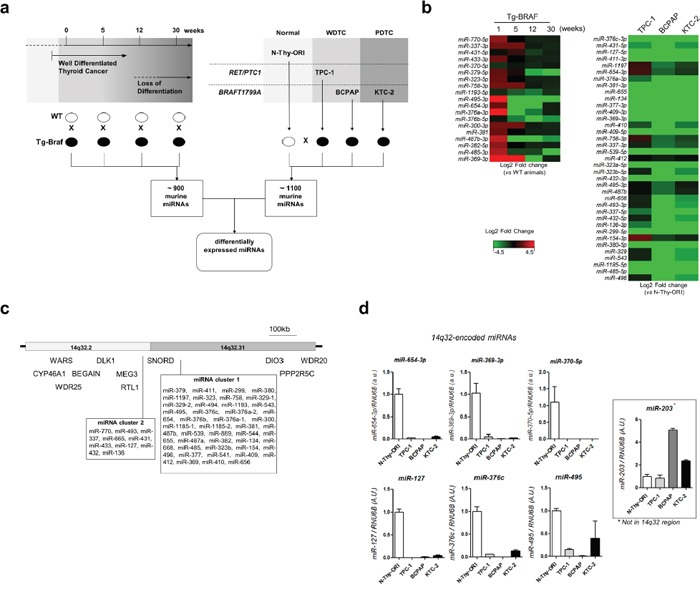Down-regulation of 14q32-encoded miRNAs and tumor suppressor role for miR-654-3p in papillary thyroid cancer.
Papillary thyroid carcinoma (PTC) is the most prevalent malignant neoplasia of the thyroid gland. A fraction of PTC cases show loss of differentiation and aggressive behavior, with radioiodine therapy resistance and metastasis. Although microRNAs (miRNAs) emerged as promising molecular markers for PTC, their role in the loss of differentiation observed during PTC progression remains to be fully understood. We performed the large-scale analysis of miRNA expression during PTC progression in BRAFT1799A-transgenic animals (Tg-Braf) and thyroid cancer cell lines and identified the marked downregulation of several miRNAs from the region 14q32. Data from The Cancer Genome Atlas (TCGA) confirmed the global downregulation of miRNAs from the 14q32 region in human PTC. The regulatory network potentially suppressed by these miRNAs suggests that key cancer-related biological processes such as cell proliferation, adhesion, migration and angiogenesis. Among the downregulated miRNAs, we observed that miR-654-3p levels decrease with long-term PTC progression in Tg-Braf mice and inversely correlate with EMT. The in vitro restoration of miR-654-3p decreased cell proliferation and migration and induced reprogramming of metastasis-related genes, suggesting a tumor suppressor role for this miRNA. In conclusion, we show global downregulation of 14q32-encoded miRNAs in an in vivo model of PTC progression. The potential circuitry in which these miRNAs are involved suggests that these miRNAs could play a key role in the pathophysiology of PTC and therefore be relevant for the development of new therapeutic strategies.
Authors
Murilo Vieira Geraldo; Helder Imoto Nakaya; Edna Teruko Kimura
External link
Publication Year
Publication Journal
Associeted Project
Integrative Biology
Lista de serviços
-
Gene regulatory and signaling networks exhibit distinct topological distributions of motifs.Gene regulatory and signaling networks exhibit distinct topological distributions of motifs.
-
Gene signatures of autopsy lungs from obese patients with COVID-19.Gene signatures of autopsy lungs from obese patients with COVID-19.
-
Network Medicine: Methods and ApplicationsNetwork Medicine: Methods and Applications
-
ACE2 Expression Is Increased in the Lungs of Patients With Comorbidities Associated With Severe COVID-19.ACE2 Expression Is Increased in the Lungs of Patients With Comorbidities Associated With Severe COVID-19.
-
Drug repositioning for psychiatric and neurological disorders through a network medicine approach.Drug repositioning for psychiatric and neurological disorders through a network medicine approach.
-
Linking proteomic alterations in schizophrenia hippocampus to NMDAr hypofunction in human neurons and oligodendrocytes.Linking proteomic alterations in schizophrenia hippocampus to NMDAr hypofunction in human neurons and oligodendrocytes.
-
In-depth analysis of laboratory parameters reveals the interplay between sex, age, and systemic inflammation in individuals with COVID-19.In-depth analysis of laboratory parameters reveals the interplay between sex, age, and systemic inflammation in individuals with COVID-19.
-
The evolution of knowledge on genes associated with human diseasesThe evolution of knowledge on genes associated with human diseases
-
Network vaccinology.Network vaccinology.
-
Pyruvate kinase M2 mediates IL-17 signaling in keratinocytes driving psoriatic skin inflammationPyruvate kinase M2 mediates IL-17 signaling in keratinocytes driving psoriatic skin inflammation
-
Transcriptome analysis of six tissues obtained post-mortem from sepsis patientsTranscriptome analysis of six tissues obtained post-mortem from sepsis patients
-
Gene Signatures of Symptomatic and Asymptomatic Clinical-Immunological Profiles of Human Infection by Leishmania (L.) chagasi in Amazonian BrazilGene Signatures of Symptomatic and Asymptomatic Clinical-Immunological Profiles of Human Infection by Leishmania (L.) chagasi in Amazonian Brazil
-
In vitro morphological profiling of T cells predicts clinical response to natalizumab therapy in patients with multiple sclerosis.In vitro morphological profiling of T cells predicts clinical response to natalizumab therapy in patients with multiple sclerosis.
-
Integrative immunology identified interferome signatures in uveitis and systemic disease-associated uveitis.Integrative immunology identified interferome signatures in uveitis and systemic disease-associated uveitis.
-
Gene regulatory networks analysis for the discovery of prognostic genes in gliomas.Gene regulatory networks analysis for the discovery of prognostic genes in gliomas.
-
Revealing shared molecular drivers of brain metastases from distinct primary tumors.Revealing shared molecular drivers of brain metastases from distinct primary tumors.

